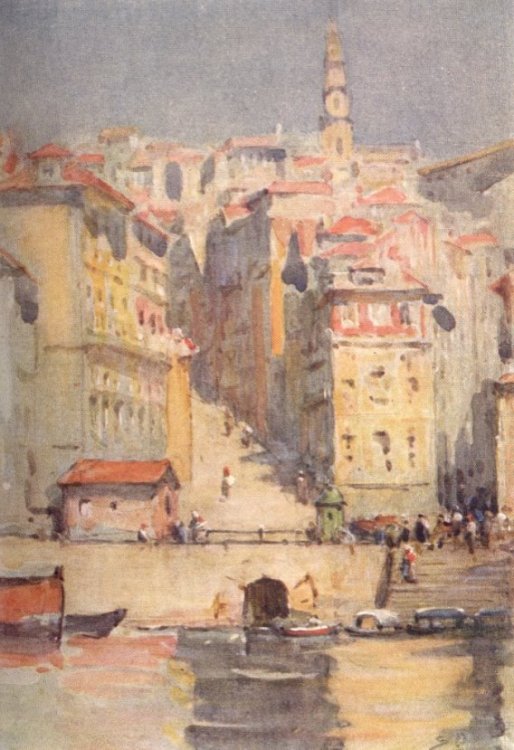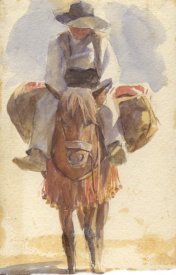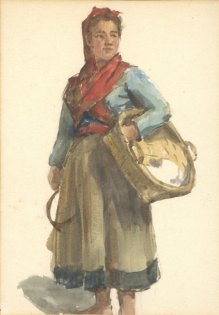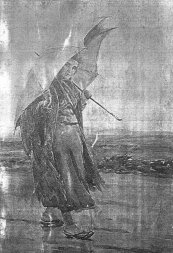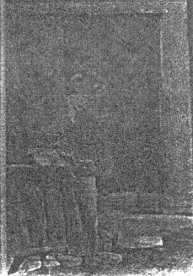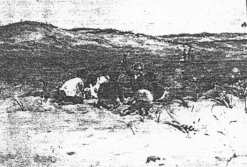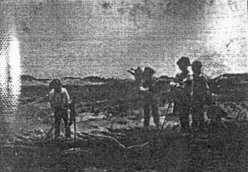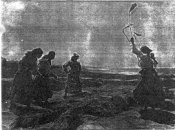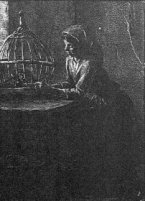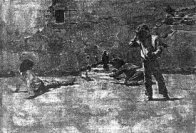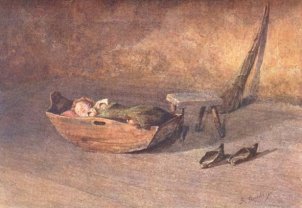[PAGE 1:]
TIMES, 22/2/1897
A little show at Mr. Dunthorne's, in Vigo-street, presents the work of an artist whose name is new to us - Mrs. S. Roope Dockery. These water-colour drawings of North Portugal are very good and decidedly original, while the country and the life which they reveal are quite unfamiliar as yet to English people. "Treading the Grape" is a fine bit of colour, "Sardine Fishers" a capital effect of sunlight; and such a drawing as that of the beggar boys, called "A Copper for St. Anthony" (32) [srd345] is very animated and expressive.
MORNING POST, 22/2/1897
MR. DUNTHORNE'S GALLERY - The series of water-colour drawings of North Portugal by Mrs. Roope Dockery here on view constitutes an interesting little exhibition. The scenery of the district meets with apt record in several landscapes, while the peasants and the industries which occupy them are also represented. Mrs. Roope Dockery draws with a light expressive touch, secures always a force of natural effect, and her colouring, bright enough when demanded by the subject, is seldom deficient in harmony. A suggestion of summer heat distinguishes "A Golden Harvest." The cloudless sky is of a violet blue, amid the yellow corn women and girls are busy at work. Humorously named is "Good Wine needs no Bush," in which a mule, profiting by the absence of its master, munches the leaves it has picked off the small bough fixed in position on one of the pillars of a little road-side inn. The drawing, in common with many of its fellows, is very sunny. Especially brilliant in key is "Nevogilde, near Oporto," a street scene. In "Douro Vineyards" the mountainous landscape gains its hue from the rich purple of the grape. The little picture may be taken as the first of several which illustrate the cultivation of the fruit and its conversion into wine. Thus we see women "Gathering Grapes," men acting as "Grape Carriers," others "Filling the Lagar;" a large stone enclosure, shown in another drawing, is heaped with fruit from which a man, bare-legged to the knees, is "Treading the Grape," in which a company of perhaps a dozen are engaged, one of whom enlivens the labour by playing the guitar. The process of "Filling the Tonels," or huge casks, is pictorially noted, "The Wine Press" is sketched and lastly we have a drawing of "Wine Boats on the Douro." Others of these water-colours are descriptive of incidents of the sardine fishery, of corn-threshing, and of the use to which oxen are put as beasts of braught.
STANDARD, 20/2/1897
MR. DUNTHORNE'S GALLERY - In minor Exhibitions generally, the Preface is no doubt overdone, since for every such Introduction penned by a competent or distinguished writer, there are ten that are penned by gushing brother artist or babbling amateur. Mr. Dunthorne - who exhibits just now a collection of Water Colours by Mrs. Roope Dockery - is not given to Prefaces at all; but the present little Exhibition would have been precisely a fiting occasion for one; and it should not have been laudatory, nor even critical, but simply explanatory. Certainly, the designs of Mrs. Roope Dockery are, as work, sufficiently lucid; but they deal with scenes and people in North Portugal, and no European Country is less visited by the cultivated tourist. Accordingly, explanation, comment - information, in fine - would have been for once, really useful; but without it even, we can enjoy, in a reasonable measure, Mrs. Roope Dockery's work, which, though it may be sketchy, never elaborate, never actually subtle, is not without refinement, and is habitually livid. The strong points of her water colours are, perhaps, their illumination and colour. No timid sun of our English South-Western counties floods the Portuguese coast. The work is broad and massive, like the effects it aims to reproduce. Now and again, as in the cradle-piece, "While Mother's at Work in the Fields" (No. 6), [srd009] it is more minutely observant. This is a charming little drawing. But, presumably, more charactoristic of the land are "Filling the Lagar" (No. 20), "Removing Stalks" (No. 22), "Treading the Grape" (No.24). In these an audacious richness and fulness of colour has been transferred from the scene to the paper. Nor is "The Brass Lamp" (No. 15) - with the lamp held aloft, and the lifted, arm and the light upon the large and rounded woman's face - a less happy evidence of the measure of Art which is at Mrs. Roope Dockery's command.
GLOBE, 24/2/1897
At Mr. Dunthorne's gallery in Vigo street, yet another lady is in evidence. Mrs. Roope Dockery is showing there 76 water-colour drawings of North Portugal. They are not of extroadinary merit, but have certain qualities of strong colour and frank expression which save them from being commonplace. They seem to be, for the most part, rapid notes of the scenery and rustic life of the country represented, and are valuable chiefly on account of the vivid manner in which they depict a district which is somewhat out of the beaten track. In handling they are occasionally unnecessarily demonstrative, and their colour errs at times on the side of discordance, but generally they are by no means incapable.
[PAGE 2:]
BAZAAR, 24/2/1897
FINE ART. Mr. Dunthorne's Gallery - MR. DUNTHORNE never lends himself to exaltation of the incapable, therefore we know that when invited to see a collection of water-colour drawings by Mrs. Roope Dockery, the display would not be of ordinary feminine character and stamina. Indeed, our recollection of an occasional drawing shown by her at the Royal Institute helped us to that conclusion, for her touch is liquid, and she has remarkable aptitude in drawing childish figures of the Arab class, besides skill in rendering pure sunlight. One drawing we remember was so like "Idling" in the present collection - and one of the best too - that it may, perhaps, have been the same. Mrs. Dockery has distinct individuality, and by going to North Portugal for the subjects of the drawings at 5, Vigo Street, she has broken very fresh artistic ground - one also that provides wealth of colour. This is notably the case in all those scenes having to do with wine-making from the purple grape. Her least successful drawings are those of pure landscape; here there is more effect of labour, and there is a degree of amateurishness in them which is entirely absent from interiors, figures of children on open ground, such as the well-shaped group "A Conto (a million reis) on the Card," or of Portuguese labourers and wine-makers.
Mrs. Dockery, though delightfully warm and luminous in her sunny scenes - like that of the walled space in which a man sits "Stringing Onions"; or where "Grape-carriers" pass beneath a high flat wall flooded with sunshine, bearing panniers of juicy grapes; or the humorous drawing which, nevertheless, has none of the regretable element, theintentionally comic, "Good wine needs no bush," an ass eating the bough tied to the verandah post - is equally clever in distributing feeble light within dark apartments. How well she does this, and makes the shadows both relative and permeable, is seen in the bare room with a cradled baby alone. "While Mother's at Work in the Fields," [srd009] and the stone-walled "Kitchen of an old Convent," with an ancient dame beside a fire on the hearth-stone. These and many others are good, but best of all, and the most unusual, are deep rich colours of purple and grey in the wine-making scenes. These comprise "Gathering Grapes" from the low-growing vines; "Removing the Stalks," the semi-transparency and consistency of heaped-up masses of the fruit in a stone room being edmirably conveyed; "Filling the Lagar," and the lagar filled to the brim with purple juice, in which are men up to their knees "Treading the Grape." Other of the nicest drawings have to do with "Muzzled Oxen" treading out corn, or women wielding flails in threshing out maize (76).
GLASGOW HERALD, 22/2/1897
Mrs Roope Dockery's drawings are quite of another character. They are not idyllic, dreamy; they are strong direct, vivid, rich in colour, as befits their subject - Portugal has been less painted than its neighbouring southern lands, and Mrs Dockery has studied many of the characteristic occupations of the peasants in the time of harvest and of vintage. It is the late autumn aspect of Portugal, with its three harvests of corn, wine, and sardines. There are drawings of the picturesque villages and town streets, with their white walls and embowered pergolas; a girl sits in a sunny space stringing onions; "A Rainy Day" shows a girl trudging along the road with a palm-leaf rain cloak; a group of players play an exciting game of cards, "A Conto on the Cards;" while "The Last Hole, Espinho," [srd340] proves that golf even is known to the Portuguese.
DAILY CHRONICLE, 24/2/1897
Even the critic does not look for a literary masterpiece in every book of travel. For a man may write a record of his adventures that will be entertaining and useful, though with no pretence to the distinction of "A Sentimental Journey" or "Through the Cevennes with a Donkey." And so it is with the wanderer who carries a sketch-book. His studies or memoranda may, topographically or as the notes of a gay and sympathetic observer, have their interest, even if they cannot compete with the sketches of a Turner or a Decamp. Certainly, Mrs. S. Roope Dockery, who has been to North Portugal, gives, in a series of water-colours now at Mr. Dunthorne's Gallery, a pleasant and lively impression of the country through which she journeyed - of its roads, blinding white in the sunshine, and its hillsides purple with vineyards, of its peasants at work in the fields and the wine press, threshing corn, or weaving as they watch their cattle. The heat of noonday, the glory of sunset, the solemnity of evening among the hills, she has also tried to express; and if her work lacks the greater qualities, it is at least careful and honest and appreciative.
[PAGE 3:]
ECHO, 24/2/1897
PICTURES OF PORTUGAL - Mrs. Roope Dockery's water-colour drawings of North Portugal at the Rembrandt Head Gallery, Vigo-street, are chiefly reminiscences of the country round Oporto and the bold mountainous banks of the Douro. They are no doubt faithful delineations of the places and people, and the local colour has been happily caught. The picturesque life in the vineyards forms the subject of a good many of them, but other aspects of life have not been neglected, the sardine fishery for example, as in "Preparing for the Market," a group of girls on the beach manipulating the fish in silvery heaps and chattering gaily the while, and "Sardine boats - Espinho." The boats drawn up on the beach are pictesque but frail-looking craft, with towering slender prows turned up like Dutch skates. "The Last Hole - Espinho" [srd340] represents a group of urchins watching with animated interest the finish of a game which seems to be a Portuuese version of golf. "Spinning Tops" and "A Copper for St. Anthony," [srd345] the latter a Portuguese equilalent of the August "Remember the Grotto" of the London arab, in which the image of the saint does duty for the oyster-shells, are clever and spirited transcripts of gamin life in the South. "A Nora" will be familiar to the Egyptian tourist under the name of Sakeeyah, the Persian irrigation-wheel, worked by a bullock, and it is an instance of the singularly Oriental tinge of the most westerly country in Europe. Among the single figures, one of the best is "A Woman of Oporto," who is shown in profile, holding a distaff. In "Filling the Lagar," a man emptying a creel of grapes on to a heap on the floor, the artist has made a happy use of the rich violet bloom of the fruit, as also in "Removing the Stalks" and "Carrying Grapes, Alto Douro." But "Treading the Grape" is the most characteristic of these vineyard subjects. The men are knee deep in the ruby liquid, which slops over the sides of the stone tank in red splashes. They are smoking, of course, and one would like to know if the ash from their cigarettes is contributed to the liquor, and they tread to the sound of a mandoline. Among the landscapes "Regoa" is perhaps the best, a citron sky and ashen grey strata of cloud reflected in the shining river that winds into the purple hills. The town red and white in shadow, and the foreground, a vineyard, is a delicious blending of olive, gold, and red bronze tints. "Into the Heart of the Douro," here a rapid stream slipping through a steep valley; "Wine Boats on the Douro," and "Roeda," where we are in a higher region, with fleecy clouds resting in the folds of the dark mountains, are all delightful bits of scenery. Mrs. Dockery's colour is pure and luminous, whether in a hill empurpled with vines, a heap of golden maize, or mellow sunlight on an old whitewashed wall. Her execution is spirited, direct and simple, not manuered in any way, yet possesses a certain quality of daintinese which gives it charm.
PALL MALL GAZETTE, 23/2/1897
The Rembrandt Head - Mr. Dunthorne exhibits a collection of water-colour drawings, illustrating North Portugal, by Mr. S. Roope Dockery. It is not work to stimulate an artist, nor for that matter to offend him; but it is decent work and interesting to those who would see something of North Portugal. The landscape sketches are rarely equal to the figure scenes in sun or shade, outdoors or indoors. Perhaps the mountain view "Douro Vineyards" should be called one of the best, and "Sardine Boats: Espinho" is fresh in colour and not badly arranged. Generally speaking, disageable lines, a want of luminousness, and a somewhat unprofessional execution spoil the landscapes. Amongst the figure pictures, such things as "Sardine Fishers Preparing for Market" and "Treading the Grape" show considerable sense of picture-making and an intelligent placing of the human figure. The first takes place on an open sunlit beach, the second in a dim interior. R.A.M.S.
DAILY GRAPHIC, 2/3/1897
PICTURES OF PORTUGAL - Spain has long been a popular hunting ground for artists in search of the picturesque, and whether they be painters of figure like Mr. Burgess or Limners of landscape and architecture like Mr. Rimington, they find an inehaustible supply of subjects for their pencils. Portugal has up to the present time been but sparsely visited by the British painter, but those who know it well aver there is ample material which will form equally attractive themes for the figure painter and the paysagiste. Anyone who might have been disposed to question this would speedily have his soubts dissipated by the visit to the Rembrandt Head Gallery, where may be seen a collection of water-colour drawings of North Portugal by Mrs. Roope Dockery. We are heartily glad to welcome anyone who opens up a fresh country for artistic annexation, and Portugal has up to the present time been so little utilised for such purposes that it may be practically considered to be new.
But beyond the novalty of the subjest we may cordially receive these drawings for their own sakes. There are considerably over seventy of them, and it will be seen that Mrs. Dockery has fully availed herself of the rich and varied picturesque possibilities of the subjects. The collection is pleasantly varied, and shows that the artist is equally at home in figure and landscape, and especially successful when she essays a combination of the two. Portugal, it would appear, presents not a few fine opportunities for the colourist. These chances have not been neglected, as one may easily see by such pictures as "While Mother's at Work in the Fields," [srd009] "The Brass Lamp," The Old Press," and "Cinerella's Coach-house." The familiarity of the artist with various phases of life, and her skill in depicting them, are strongly in evidence in such works as "Hoeing the Young Maize," "Sardine Fishers - Preparing for the Market," "Treading the Grape," and "Threshing the Corn." The whole collection is interesting as a pictorial record of phases of every-day life in a country with which the British tourist is not yet as familiar as he might be.
[PAGE 4:]
WORLD, 03/3/1897
Mr. Dunthorne's gallery in Vigo Street is always worth visiting, and his present exhibition of water-colour drawings of North Portugal, by Mrs. Roope Dockery, should not be missed. Mrs. Dockery has the not too common quality of firm draughtmanship; she is at her best in her largest drawing, "Treading the Grapes," a group of men in a wine-vat, smoking, dancing, and playing the guitar, as, with their trousers rolled up and their bare legs crimsoned with the grape juice, they trample down the mass of fruit. The figures are admirably drawn and modelled, and the colour rich and vigorous. Mrs. Dockery excels in rendering dark rich harmonies of colour, as in the sketch of the deserted baby in its cradle [srd009] , and in "The Old Press" and "Filling the Lagar". Among her landscapes the best are "A Wreck, Caminha," "Douro Boat, Evening," "The Frontier Fort of Caminha," and "Douro Vineyards"; while "The Last Hole, Espinho," [srd340] proves that golf has actually penetrated to North Portugal.
WINE & SPIRIT GAZETTE, 27/2/1897
WINE PICTURES AND OTHERS BY MRS. ROOPE DOCKERY, OF OPORTO - There are 76 water-colour drawings, all descriptive of the North of Portugal, in which the spring, summer, and autumnal tints are faithfully reproduced by Mrs. Dockery, who is not only an artist, but evinces in all her work poetical inspiration. She presents us with landscapes, seascapes, portraits, &c., all teeming with that which is most essential in art - descriptive power. The pictures which naturally most interested us were - (19) Grape Carriers; (20) Filling the Lagar; (21) Gathering Grapes; (22) Roemoving the Stalks; (24) Treading the Grapes; (25) The Wine Press; (26) Filling the Tonels; and (27) The Old Press. These are not only racy of the soil, but are faithfully and admirably rendered. Of course, we must recollect that Mrs. Dockery, although of English extraction, was born in Portugal, and comes of one of the oldest port wine families, so that all she now presents for the appreciation of the British public is representative of the surroundings of her childhood's days. But these pictures in all their detail and accurate colouring have been to her a labour of love, for this truth is evinced in every effort. Mrs. Dockery, furthermore, has a keen sense of the humourous, as is instanced in (65) "Good wine needs no brush," where the modern Babieca is quietly eating the one placed outside the "tenda." Of the river Douro we have views of (17) the Quinta de Chancelleiros, of (23) Regoa, of (31) the Quinta da Cochucha, (42) a Douro boat, (50) Wine boats - misty morning, Ec. In Portraiture, one of the best executed is (15) The Brass Lamp, where a girl, typical of the Douro, is holding an old-fashioned brass lamp.
[PAGE 5:]
SUN, 01/3/1897
Mrs. Roope Dockery's water-colour drawings of North Portugal, on view at the Rembrandt Head Gallery, in Vigo-street, are excellent, vigorous in drawing and colour. Mrs. Dockery has a keen intuitive sense of composition, and the "Sardine Fishers Preparing for Market," - a small group of women seated in graceful, natural attitude on the stretch of yellow sand, busy with the gleaming fish - is an excellent example. So also are "Spinning Tops" and "The Brass Lamp."
MORNING, 02/3/1897
REMBRANDT HEAD - North Portugal offers an almost endless variety of attractive subjects to the brush of the artist, if judgment is to be based on the collection of water-colour drawings now on view at this gallery, the work of Mrs. S. Roope Dockery, who has sought her studies far from the beaten track, and so has succeeded in placing before us unfamilliar and pituresque scenes. Although there is warmth, light, and colour in these little drawings, they are never too brilliant, the artist relying for that effect on pleasant harmonies and clear, well-diffused sunshine. The vine harvest is one of the most effective subjects, and Mrs. Dockery is very successful in dealing with the masses of rich purple fruit as they are being emptied into the lagar; or again in "Treading the Grape," in which she gives us figures of men knee deep in the ruddy juice as they crush the fruit. This drawing is interior, and the figures of men have a wonderful sense of motion, especially those in the middle distance. The yoked oxen, as in "Mind over Matter" and "Lazily, Drowsily," make for the picturesque with their long horns and heavy harness; while "Sardine Boats" show us as quaintly shaped craft as ever sailed, and in "Sardine Fishers Preparing for Market," the artist has, in our opinion, touched her high water mark. It is a sea-shore scene. The fish, almost jewel-like in brilliance, lie on the yellow sand, the busy women sorting them into heaps. The sky overhead is vivid blue; the sea a colour, in which there is a latent suggestion of purple. A much less ambitious work, but one hardly less successful, is "Into the Heart of the Douro," a winding stream which creeps between high purpleish hills, the water reflecting their colour and that of a delicate azure sky.
TOPICAL TIMES, --/-/1897
There is now on view at the Rembrandt Head Gallery, Vigo-street, a capital collection of water-colour drawings of North Portugal by Mrs. S. Roope Dockery. This is decidedly worth a visit.
DAILY NEWS, 1/3/1897
DRAWINGS OF NORTH PORTUGAL - A small exhibition, well worth seeing, is that which now occupies the recesses in Mr. Dunthorne's Gallery in Vigo-street. Its chief interest is that the sketching ground covered by the artist, Mrs. S. Roope Dockery, is not a hackneyed one, but, on the contrary, gives us something fresh in local interest as well as in the manner of representation. The artist illustrates topographical features, with pleasant passages of colour and pictorial description of the everyday occupations of the peasant classes, and when dealing with such matter-of-fact processes of filling, storing, and shipping, that go to the making of one's glass of after-dinner port. Other industries, of the maize field, of the cottagers' spinning, the sardine fishing, and the labour of the Douro oxen, have the same good drawing and local colour accorded to them.
MANCHESTER COURIER, --/-/1897
It should also be mentioned that another lady, Mrs. S. Dockery, exhibits at the Rembrandt Head Gallery an interesting series of drawings of North Portugal, a country not often visited by artists.
E. ANGLICAN DAILY TIMES, --/-/1897
Some of the other small galleries worth going to see at the present time include Dunthorne's at which a Mrs. Dockery exhibits some pretty little fancies in North Portugal, one or two illustrating the very undesirable practices in the making of wines.
HEARTH & HOME, --/-/1897
Mrs. Roope Dockery, who recently made a sketching tour throughout North Portugal, is now holding at Mr. Dunthorne's Gallery an exhibition of the water-colour paintings she made on this occasion. Many of them are charming little pastoral scenes showing the peasants at work stripping the vines, threshing the corn, or weaving as they mind the cattle.
[PAGE 6:]
TOPICAL TIMES, --/-/1897
Mrs. S. Roope Dockery's Exhibition at Dunthorne's Gallery, Vigo Street, is a decided success. The whole of the water-colours relate to life in North Portugal, and it is somewhat to be regretted that the catalogue has not been annotated, as the enjoyment of the average visitor would have been doubled had he or she had the assistance of a few notes especially as regards Nos. 32, 36, and 39. The artist's great success is in her figure pieces, for she possesses the faculty of imparting life and movement in a high degree. Nos. 32 and 36 are admirable examples of her power in this respect, while No. 60, "Good wine needs no bush," where the muleteer in search of refreshment leaves the mule outside the wine shop, the mule sympathesising with its master's feelings and recognising the force of the above proverb calmly proceeds to devour the "bush" hung at the door as a sign. Space will not admit of a more detailed criticism of an excellent exhibition which it is to be hoped will not be Mrs. Dockery's last.
QUEEN, 6/3/1897
MRS. ROOPE DOCKERY has some charming water-colour drawings of North Portugal on exhibition at Mr. Dunthorne's Gallery. Among them is an interesting series illustrating the cultivation of the grape and its converasion into wine. A woman is depicted gathering grapes, and we see men acting as grape carriers, while the process of treading the grapes and filling the tonels (large casks) are most picturesque.
BLACK AND WHITE, 6/3/1897
At the Dunthorne's, in Vigo Street, is a pleasant exhibition of water-colour drawings of North Portugal by Mrs. S. Roope Dockery. Just a few of them, relating to the making of wine, are interesting rather as documents than pictures; the colour inclines to muddiness, probably because the artist strove too earnestly after a literal accuracy. The fault is the more striking, because in the beauty and clearness of the colouring lies the especial charm of most of the drawings shown. This fact is notable in Sardine Boats, a sketch of sand with boats of a form so delightful that you wonder boats are ever built in any other shape. There are some bright little studies of children at their games - A Conto on the Card and A Copper for St. Anthony [srd345] . Those same delightful boats appear in Sardine Fishers Preparing for Market, one of the best and sunniest of the drawings shown. Finally Cinderella's Coach-house is a bit of still life as pleasing in colour as the title is in fancy.
[PAGE 7:]
NEW SATURDAY, --/-/1897
Lastly, Mr. Dunthorne is exhibiting in his rooms at Vigo Street some water-colour drawings of North Portugal by Mrs. S. Roope Dockery. They hardly amount to more than sketches, but as such they display a feeling for colour and a power of composition which are very noticable.
OBSERVER, --/-/1897
At the Rembrandt Head a collection of Portuguese water colours is on view. They are the work of Mrs. Dockery, and deal with such themes as "Treading the Grapes," "The Wine Press," "The Sardine Boats," and so on. Though somewhat loose in the modelled surfaces, and not always certain in colour, the artist shows a delicate feeling for natural beauty, particularly in regard to composition and line, and her work is thoroughly racy of the soil.
LADYS' PICTORIAL, --/-/1897
The collection of water colours, by Mrs. S. Roope Dockery, which fill this pretty little gallery, are singularly attractive, apart from their topographical interest. Mrs. Dockery has found her sketching ground in North Portugal, and in a series of drawings presents scenes as charming as unfamiliar to our eyes. The grape harvest is one of her most attractive subjects, and very cleverly she has painted the masses of rich purple fruit, both before and after it has been gathered. "Treading the Grape" is one of her most ambitious drawings, men wading through the ruddy juice as they press the fruit, some of them playing mandolines, others smoking, the sense of motion being well conveyed. Bullocks, both treading the corn and tilling the ground, make attractive subjects; and the quaint little craft of the sardine fishers has provided Mrs. Dockery with picturesque matter, and her "Sardine Fishers preparing for Market" is an altogether bright and joyous little work, the brilliancy of the fish heaped on the yellow sand, the distant sapphire sea, and the clear fresh atmosphere, making it a picture one should like to live with.
QUEEN, 13/3/1897
MRS S. ROOPE DOCKERY is now showing at this gallery some of her water-colour drawings of North Portugal. They are beautiful studies - many of them very highly finished - and furnish an excellent idea of the country, its vineyards and wine making, boats, and harvests, with the peasants in various occupations. The process of gathering grapes, treading them out, and making them into wine is seen in "Filling the Lagar," "Removing the Stalks," "Treading the Grape," and "Filling the Tunels." Illustrative of the general subjects are "Threshing the Corn," women at work with flails; "Sardine Fishers Preparing for Market;" "A Golden Harvest," women reaping corn and making up sheaves; and various other designs, alike clever and suggestive.
[PAGE 8:]
DIARIO DE NOTRE, LISBOA, 2/3/1897
Carta de Londres (Correspondencia particular do Diario de Noticias): - Londres, 26. - Experimentei um grande prazeresta manhã visitando a galeria Rembrandt na Vigo Street, onde uma pintora aguarellista de talento, madame Roope Dockery, expõe uma serie de quadros - cincoenta e tantos numeres representando o porte de Portugal, as poeticas e luminosas reminiscencias do Porto e arredores, as soberbas margena do Douro. Os assumptos são a vindima, a pesca da sardinha, um honito grupo de reparigas tirando e peixe das redes; este quadro tem o nome de "Sardine Boats" - Espinho -, depois um bello retrado: "Uma mulhar do Porto", payzagens, marinhas, tudoisto resplendente de sol e vida.
Passsei assim duas boas heras admiraudo esta bonita collecção de quadros portuguezes e os visitantes eram numerosos, extasian-do-se ao cé de mim. A imprensa londrina fax grandes elogios a exposicão de madame Roope Dockery.
THE STAR, --/-/1897
There is a smaller, and in several ways, more interesting collection of water-colours at Mr. Dunthorne's Gallery, in Vigo-st.: drawings of North Portugal by Mrs. S. Roope Dockery. They are frankly intended to serve as notes of travel, and they succeed in giving one a very vivid impression of the country, with its vineyards and wine - presses, its blinding white roads and broad-horned oxen, its rivers and hills, its peasants at work in the fields and in their homes. A. U.
THE ARTIST, --/-/1897
IN THOSE artistically arranged compartments at the Rembrandt Head. Mr. Robert Donthorne is exhibiting an interesting collection of water colour drawings of North Portugal by Mrs. Roope Dockery. In many of the drawings, the artist displays considerable skill in conveying an impression of hot blazing sunlight with its accompanying strong shadows, and most of her figures are full of vigour and life. In her interiors, however, Mrs. Dockery seems less sure in her effects, and apparently produces her shadows and dark tones with layer upon layer of wash instead of with one only of the right value and depth.
Her habit, too, of painting hills with small bars of wash, is not to be commended, giving, as it does, a patchy appearance undersirable in connection with this medium, where broad simple treatment is so much more effective.
The subjects are unhackneyed, and the literary interest, as the phrase goes, of much of her work is fresh. No. 24, "Treading the Grape," for instance, is a drawing which to port-consumers donne furieusement a perser pressing out the purple juice with bare legs. To avoid monotony, and to encourage activity, we presume, one of the figures is playing a stringed instrument and another is dancing, while two others are smoking.
MADAME, 20/2/1897
At Dunthorne's dainty little gallery Mrs. S. Roope Dockery shows seventy-six water-colours of North Portugal. If , as pictures, they are not always irreproachable, they betray a vivid appreciation of good subjects. This is especially true of several vintage scenes, notably "Treading the Grapes" (No.24), and "The Wine Press." Several groups of street urchins - "A Copper for St. Anthony," [srd345] "A Conto on the Card," especially - are truly seen and well recorded. A very decorative little picture, "Sardine Boats," Espinho (No. 33), is perhaps the most novel and satisfactory of the small sketches. But the whole collection reveals much pleasant work, and a little that deserves higher praise.
[PAGE 9:]
-----, --/-/----
Mrs. S. Roope Dockery's two brightly-coloured little pictures, "Maize Threshing, Portugal," and "Launching Sardine Boat, Portugal," recall her exhibition of the Rembrandt Head some time ago.
LADIES FIELD, 1/4/1899 - Text surrounds painting.
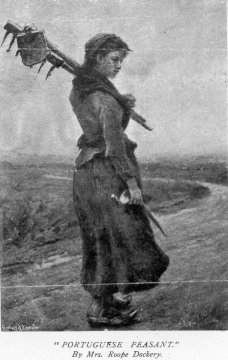
Mrs. Roope Dockery has had the distinction of a one-woman show at Mr. Dunthorne's gallery. Mr. Dunthorne does not exploit the feeble. Although Mrs. Dockery has exhibited only for a few years, her water-colours, with their rich hues and fluid touch, attracted attention directly she appeared on the Royal Institute walls, which, I believe, was in 1894, with a child on the a plank over a stream - "Reflections." At Dunthorne's her drawings were wholly of life in North Portugal. The clever young artist, Mr. Claude Hayes, R.I., son of Mr. Edwin Hayes, the marine painter of the Royal Hibernian Academy, gave Mrs. S. Roope Dockery a few lessons. - R. C. G.
